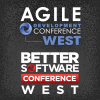Agile Development Conference & Better Software Conference West 2010

PRESENTATIONS
|
Business Rules and Data Requirements: In Tandem for Success
Business rules and data needs are essential ingredients for a balanced set of requirements and are vital for successful product delivery. When analyzing requirements, some teams focus on business rules at the expense of data. Others dive deeply into modeling data, skimming over or skipping business rules. When it comes to delivery, if either data or rules are inadequately elaborated, you risk not delivering the right requirements and wasting precious time and money. |
|
|
Cards, Conversation, Confirmation: Interviewing Skills for Agile Requirements
Valuable products start with understanding the needs of the customers-what they want and how they will use the product. Agile projects commonly capture customer needs as user stories-notes written on cards as a reminder to have an in-depth conversation when development begins. Most customers aren't born with the ability to communicate clearly and unambiguously-whether in stories or conversations-with fully formed requirements statements. |

Esther Derby, Esther Derby Associates, Inc. |
|
Coaching Agility--Producing Value
If you are an agile coach and your team or organization is struggling to adopt agile methods or is backsliding, this class is for you. David Hussman shares coaching techniques you can use to grow sustainable agility that lasts beyond the early iterations and the first few agile projects. David begins with a series of tools to help you build a solid foundation: assessments, pragmatic practice selection, chartering, and product planning tools. |

David Hussman, DevJam |
|
Collaborating with Non-Collaborators
We understand the vital importance of collaboration among team members. However, how can we deal with non-collaborators-people who won't work with us? Although we may not be able to change them, we may be able to work with them or around them. Pollyanna Pixton describes how to identify non-collaborators-a leader, team member, team, or even a process. She then examines the system within which the non-collaborators work: their success factors, motivations, measurement and reward systems, fears, hot buttons, and hidden agendas. |

Pollyanna Pixton, Accelinnova |
|
Earned Value Management (EVM) Demystified
Earned Value Management (EVM) is one of the key topics in most all project management courses and is part of the Project Management Institute's PMP® certification and PMBOK®. However, many software project managers do not understand EVM well-and even fewer practice it well. James McCaffrey demystifies EVM, explores its benefits, and clearly explains the often confusing terminology-planned value, earned value, actual cost, schedule variance, schedule performance index, cost variance, and cost performance index. |

James McCaffrey, Volt VTE |
|
Eliminating Process Bottlenecks: The Theory of Constraints
Managers often fall into the trap of making sure that everyone is busy. It seems logical that we should keep all of our highly paid “resources” (ouch!) fully utilized. Surprisingly, optimizing for maximum utilization (busyness) actually creates less business value. Not surprisingly, it also can lead to quality problems, lowered job satisfaction, and even burnout. Join Chris Sims for this experiential session about the Theory of Constraints in which we explore better ways of optimizing how teams work. |

Chris Sims, Agile Learning Labs |
|
End-to-End Agile Planning: Oxymoron or Powerful Release Planning Method?
It's a very common pattern. Agile methods don't seem to specify much in the way of preparation or strategies for project planning-so teams simply dive-in and start iterating toward a solution to their business problems. In some contexts, such as small-scale simple projects, this works just fine. However, what if your project is more complex? How do you determine a budget when you have a distributed or larger-scale project and no real requirements? |

Bob Galen, iContact |
|
Enterprise Agile Adoption: Barriers, Paths, and Cultures
While agile adoption continues to grow rapidly in the software product development world, it has not been as widely adopted within enterprise IT departments. Even within a single company, different software organizations can have widely varied views on adopting agile concepts. Some groups are fanatical about the “A-word”; others are skeptical and dismissive. Using Medtronic as a case study, Mike Stuedemann examines the barriers to agile adoption within large, multinational corporations. |
|
|
Estimating Business Value
Agility focuses on delivering business value to the customers as rapidly as possible. So, how does the team assure the business that it’s delivering the most value possible in the right priority? It’s more than prioritizing user stories or estimating development effort with story points. Through presentation and interactive exercises, Ken Pugh explains how to estimate and track business value throughout an agile project. |

Ken Pugh, Net Objectives |
|
Facilitation Patterns for Interaction Satisfaction
Good facilitation skills are essential for everyone in development. In fact, everyone facilitates whether they know it or not. If you work on a team, manage an organization, or simply work with others, the opportunity to facilitate arises often. Steven "Doc" List leads delegates in exploring the common patterns and anti-patterns-for both the facilitator and the participants-he's seen and experienced during facilitation interactions. |
|


